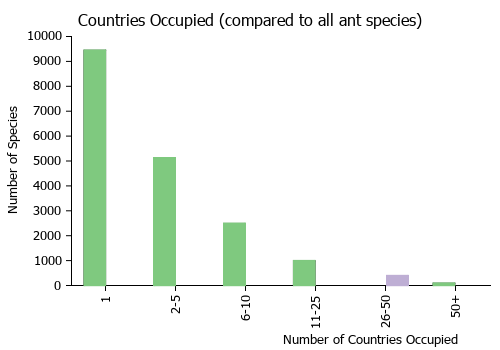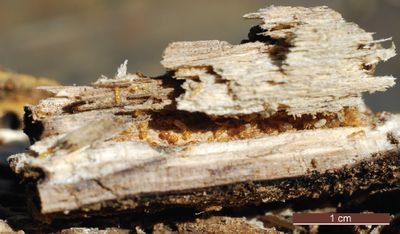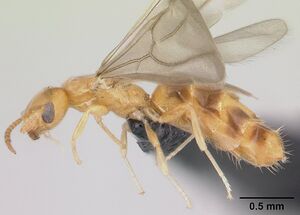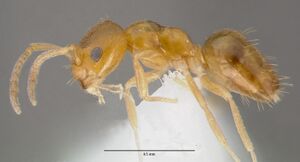| Common Name
|
|
|
| Usu-hime-ki-ari
|
| Language:
|
Japanese
|
|
|
| Little Yellow Ant
|
| Language:
|
English
|
Plagiolepis alluaudi is a tiny Old World ant that has spread to many parts of the world through human commerce. It is a primarily tropical species, apparently native to Madagascar and neighboring islands. It has become a pest on Pacific islands and in European greenhouses (Wetterer, 2013). Pashaei Rad et al. (2018) found this species in Iran in a low rainfall forest while in Japan it is found in open land (Japanese Ant Image Database).
Identification
Plagiolepis alluaudi is a tiny yellow ant (total length 1.5 mm approximately), whose workers have eleven antennal segments. In addition, this ant has a round head with strongly convex posterior margins unlike Plagiolepis exigua (also yellowish), which has an oblong head (Wetterer, 2014; Hernandez-Teixidor et al., 2020).
Distribution
This ant is primarily a tropical species, native to the Afrotropical region (Guénard et al., 2017). It has been introduced into the Australasian, Indo-Malayan, Neotropical, Oriental and Palaearctic regions (Wetterer, 2014), and has been spread worldwide through human commerce (Wetterer, 2014). In the Canary Islands, Staab (2019) recently reported it for Tenerife, but in our sampling, it was detected in three localities on Gran Canaria, one on La Palma and one on Tenerife (Hernandez-Teixidor et al., 2020).
In Japan, this species is known from the Ogasawara Islands (Shindo, 1979; Masuko & Terayama, 1984), but it has not been recorded from the Nansei Islands (Japanese Ant Image Database).
Afrotropical Region: Comoros, Kenya, Nigeria, Saint Helena.
Australasian Region: New Caledonia, Norfolk Island.
Indo-Australian Region: Borneo, Cook Islands, Fiji, French Polynesia, Hawaii, Indonesia, Malaysia, New Guinea, Niue, Solomon Islands, Tonga, Vanuatu.
Malagasy Region: Madagascar, Mayotte, Réunion, Seychelles (type locality).
Neotropical Region: Barbados, Bermuda, Grenada.
Oriental Region: India.
Palaearctic Region: China, Iran, Japan, Switzerland.
Distribution based on AntMaps
Distribution based on AntWeb specimens
Check data from AntWeb
Countries Occupied
| Number of countries occupied by this species based on AntWiki Regional Taxon Lists. In general, fewer countries occupied indicates a narrower range, while more countries indicates a more widespread species.
|

|
Estimated Abundance
| Relative abundance based on number of AntMaps records per species (this species within the purple bar). Fewer records (to the left) indicates a less abundant/encountered species while more records (to the right) indicates more abundant/encountered species.
|

|
There is a single record of this species from Catalina Island, California (collected by William M. Mann; SMITH 1957). Many researchers have made extensive ant collections in California, but have never produced another record of P. alluaudi, suggesting that either the California population has been extirpated or the one record was based on a labeling error. In fact, this one record of P. alluaudi is very suspect: I have been unable to find any other records of ants collected by William M. Mann on Catalina Island (Wetterer 2013).
Biology
This species was recently found in Florida (USA). Chouvenc et el. (2018) reported:
In early 2017, foraging workers and queens of P. alluaudi were observed by TC in the Riverland neighborhood of Fort Lauderdale, Broward County, Florida (about 26.1000 °N, 80.1800 °W). The ants were feeding on the nectar of Zingiber zerumbet (L.) (cv. shampoo ginger) flowers (Zingiberaceae). For more than a decade, Pheidole megacephala was the dominant ant species in this area (T. Chouvenc, personal observation). Over a period of 6 mo, the P. megacephala populations were seemingly displaced by a minute yellow ant, and in addition to foraging for nectar, they were observed tending aphids and feeding on dead insects. In July 2017, a large group of foragers and queens invaded a Riverland household and, in response, we sought its identification.

Chouvenc et el. 2018. Figure 2. Opened nest of
Plagiolepis alluaudi from vegetative debris on the ground. (Florida, USA)
Subsequent surveys within the Riverland area confirmed that P. alluaudi forages in relatively high densities across several residential blocks. Given the infested area, it is possible that it was established for several years before being detected. Nests with brood were readily detected in dead branches of vegetation, both on living trees and on twigs on the soil surface. A partially decomposed section of a tree branch as little as 10 cm long and 2 cm diameter can host several thousand ants, including brood and several queens (Fig. 2). Detailed monitoring will be necessary to determine the current and future range of P. alluaudi in Florida and its effects on local ants and other insects. The establishment of P. alluaudi in an area previously dominated by P. megacephala populations supports Le Breton’s (2003) observation on the interaction of these 2 species in New Caledonia.
The household invasion originated from garden populations entering the structure in a relatively dense trail of workers, and included supernumerary queens foraging openly on the kitchen countertop and feeding on pet food. Three hours after application, baiting with a borate and sugar solution elicited feeding by several dozen queens and thousands of workers within the bait tube. Two days after the installation of the bait tubes, the P. alluaudi activity ceased indoors, while the ants were still active in the garden. Subsequent structural infestations were observed in the weeks following treatment, showing limited impact of the bait on the overall surrounding population.
Outside its native area, this species has been detected in natural areas such as forests, primarily in the Afrotropical region (Wetterer, 2014), as well as indoors in the Palaearctic region (Guénard et al., 2017). Apart from having a short life cycle and a wide tolerance to temperature and humidity, its success in new localities may be due to its ability to co-exist with dominant invasive ants like Pheidole megacephala (Smith, 1957; Wetterer, 2014). It has become a minor household and agricultural pest in some areas, especially in the Pacific islands and in European greenhouses (Wetterer, 2014; Hernandez-Teixidor et al., 2020).
Castes
Nomenclature
The following information is derived from Barry Bolton's Online Catalogue of the Ants of the World.
- alluaudi. Plagiolepis alluaudi Emery, 1894a: 71 (w.) SEYCHELLES IS. Forel, 1907a: 30 (q.). Senior synonym of augusti, foreli, mactavishi, ornata: Smith, M.R. 1958b: 196. See also: Smith, D.R. 1979: 1423.
- mactavishi. Plagiolepis mactavishi Wheeler, W.M. 1908c: 166 (w.) FRENCH POLYNESIA (Society Is). Wheeler, W.M. 1922f: 318 (q.); Santschi, 1928b: 37 (m.). Junior synonym of alluaudi: Smith, M.R. 1958b: 196.
- foreli. Plagiolepis foreli Santschi, 1920g: 165, fig. 1 (w.) SWITZERLAND. Subspecies of alluaudi: Emery, 1921d: 318. Junior synonym of alluaudi: Smith, M.R. 1958b: 196.
- ornata. Plagiolepis foreli var. ornata Santschi, 1920g: 166 (w.) NEW CALEDONIA. Subspecies of alluaudi: Emery, 1921d: 318. Junior synonym of alluaudi: Smith, M.R. 1958b: 196.
- augusti. Plagiolepis augusti Emery, 1921d: 317. Replacement name for foreli Mann, 1921: 473. [Junior primary homonym of foreli Santschi, 1920g: 165.] Junior synonym of alluaudi: Smith, M.R. 1958b: 196.
- foreli. Plagiolepis foreli Mann, 1921: 473 (w.) FIJI IS. [Junior primary homonym of foreli Santschi, above.] Replacement name: augusti Emery, 1921d: 317.
Description
References
- Blard, F., Dorow, W.-H.-O., Delabie, J. H. C. 2003. Les Fourmis de l’île de la Réunion (Hymenoptera, Formicidae). Bulletin de La Société Entomologique de France, 108(2), 127–137 (doi:10.3406/bsef.2003.16939).
- Borowiec, L. 2014. Catalogue of ants of Europe, the Mediterranean Basin and adjacent regions (Hymenoptera: Formicidae). Genus (Wroclaw) 25(1-2): 1-340.
- Brassard, F., Leong, C.-M., Chan, H.-H., Guénard, B. 2021. High diversity in urban areas: How comprehensive sampling reveals high ant species richness within one of the most urbanized regions of the world. Diversity 13, 358 (doi:10.3390/d13080358).
- Chouvenc, T., R. H. Scheffrahn, and J. Warner. 2018. Establishment of Alluaud's little yellow ant, Plagiolepis alluaudi Emery (Hymenoptera: Formicidae: Formicinae): first continental New World record. Florida Entomologist. 101:138-140.
- Dekoninck, W., Wauters, N., Delsinne, T. 2019. Capitulo 35. Hormigas invasoras en Colombia. Hormigas de Colombia.
- Emery, C. 1894b. Mission scientifique de M. Ch. Alluaud aux îles Séchelles (mars, avril, mai 1892). 2e mémoire. Formicides. Ann. Soc. Entomol. Fr. 63: 67-72 (page 71, worker described)
- Forel, A. 1907d. Formicides du Musée National Hongrois. Ann. Hist.-Nat. Mus. Natl. Hung. 5: 1-42 (page 30, queen described)
- Hernández-Teixidor, D., Pérez-Delgado, A.J., Daniel Suárez, D., Reyes-López, J. 2020. Six new non-native ants (Formicidae) in the Canary Islands and their possible impacts. Journal of Applied Entomology 00:1–8 (doi:10.1111/jen.12751).
- Hoffmann, B., Eldridge, J., Marston, C. 2023. The first eradication of an exotic ant species from the entirety of Australia: Pheidole fervens. Management of Biological Invasions, 14(4), 619–624 (doi:10.3391/mbi.2023.14.4.03).
- Imai, H.T., Kihara, A., Kondoh, M., Kubota, M., Kuribayashi, S., Ogata, K., Onoyama, K., Taylor, R.W., Terayama, M., Yoshimura, M., Ugawa, Y. 2003. Ants of Japan. 224 pp, Gakken, Japan.
- Krushelnycky, P. D. 2015. Ecology of some lesser-studied introduced ant species in Hawaiian forests. Journal of Insect Conservation. 19:659-667. doi:10.1007/s10841-015-9789-y
- Liu, C., Fischer, G., Hita Garcia, F., Yamane, S., Liu, Q., Peng, Y.Q., Economo, E.P., Guénard, B., Pierce, N.E. 2020. Ants of the Hengduan Mountains: a new altitudinal survey and updated checklist for Yunnan Province highlight an understudied insect biodiversity hotspot. ZooKeys 978, 1–171 (doi:10.3897/zookeys.978.55767).
- Meurgey, F. 2020. Challenging the Wallacean shortfall: A total assessment of insect diversity on Guadeloupe (French West Indies), a checklist and bibliography. Insecta Mundi 786: 1–183.
- Pashaei Rad, S., Taylor, B., Torabi, R., Aram, E., Abolfathi, G., Afshari, R., Borjali, F., Ghatei, M., Hediary, F., Jazini, F., Heidary Kiah, V., Mahmoudi, Z., Safariyan, F., Seiri, M. 2018. Further records of ants (Hymenoptera: Formicidae) from Iran. Zoology in the Middle East 64, 145-159 (doi:10.1080/09397140.2018.1442301).
- Pawluk, F., Borowiec, L., Salata, S. 2022. First record of Plagiolepis alluaudi Emery, 1894 (Hymenoptera: Formicidae) from Poland. Annals of the Upper Silesian Museum in Bytom Entomology 31 (online 006) 1-5 (doi:10.5281/ZENODO.6522444).
- Rosas-Mejía, M., Guénard, B., Aguilar-Méndez, M. J., Ghilardi, A., Vásquez-Bolaños, M., Economo, E. P., Janda, M. 2021. Alien ants (Hymenoptera: Formicidae) in Mexico: the first database of records. Biological Invasions 23(6), 1669–1680 (doi:10.1007/s10530-020-02423-1).
- Smith, D. R. 1979. Superfamily Formicoidea. Pp. 1323-1467 in: Krombein, K. V., Hurd, P. D., Smith, D. R., Burks, B. D. (eds.) Catalog of Hymenoptera in America north of Mexico. Volume 2. Apocrita (Aculeata). Washington, D.C.: Smithsonian Institution Pr (page 1423, see also)
- Smith, M. R. 1958b [1957]. A contribution to the taxonomy, distribution and biology of the vagrant ant, Plagiolepis alluaudi Emery (Hymenoptera, Formicidae). J. N. Y. Entomol. Soc. 65: 195-198 (page 196, Senior synonym of augusti, foreli, mactavishi and ornata)
- Wetterer, J.K. 2013. Worldwide spread of Alluaud's little yellow ant, Plagiolepis alluaudi (Hymenoptera: Formicidae). Myrmecological News 19, 53-59.
- Wetterer, J.K. 2017. Invasive ants of Bermuda revisited. Journal of Hymenoptera Research 54, 33–41 (doi:10.3897/jhr.54.11444).
- Wetterer, J.K., Espadaler, X., Ashmole, N.P., Mendel, H., Cutler, C., Endeman, J. 2007. Ants (Hymenoptera: Formicidae) of the South Atlantic islands of Ascension Island, St Helena, and Tristan da Cunha. Myrmecological News 10: 29-37.
- Wetterer, J.K., Wetterer, A.L. 2004. Ants (Hymenoptera: Formicidae) of Bermuda. Florida Entomologist 87(2), 212–221 (doi:10.1653/0015-4040(2004)087[0212:ahfob2.0.CO;2]).
- Wheeler, W. M. 1922k. Ants of the American Museum Congo expedition. A contribution to the myrmecology of Africa. IX. A synonymic list of the ants of the Malagasy region. Bull. Am. Mus. Nat. Hist. 4 45: 1005-1055 (see also)
- Wilson, E. O.; Taylor, R. W. 1967b. The ants of Polynesia (Hymenoptera: Formicidae). Pac. Insects Monogr. 14: 1-109 (see also)
- Yode, C.-V.D., Dosso, K., Kouakou, L.M.M., Kolo, Y., Dekoninck, W., Konate, S., Kouassi, K.P. 2020. Evaluating Efficiency of Different Sampling Methods for Arboreal Ants (Hymenoptera: Formicidae) in A West African Forest-Savanna Mosaic. Sociobiology 67, 492-500 (doi:10.13102/sociobiology.v67i4.5558).
- Yu, Y. 2016. Risk of alien species introduction to Ogasawara Islands : Case study of ants at Tokyo Port. World Heritage Studies 1, 86-89.
- Wetterer J. K. 2014. Worldwide spread of Alluaud's little yellow ant, Plagiolepis alluaudi (Hymenoptera: Formicidae). Myrmecological News 19: 1-7.


































































